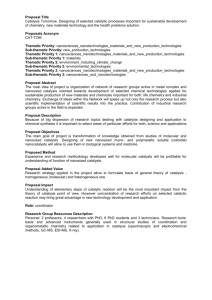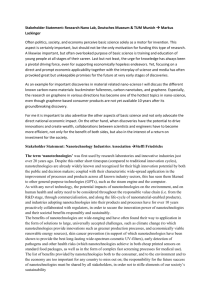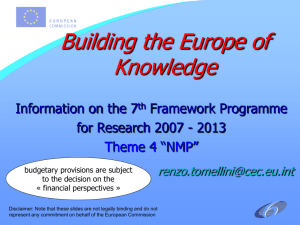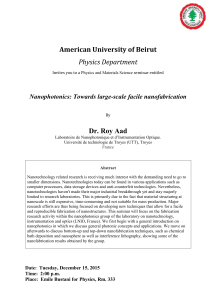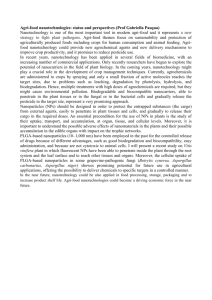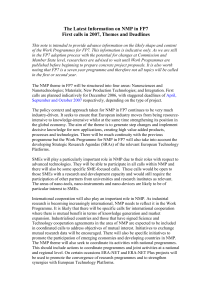Building Europe Knowledge: Towards the Seventh Framework
advertisement
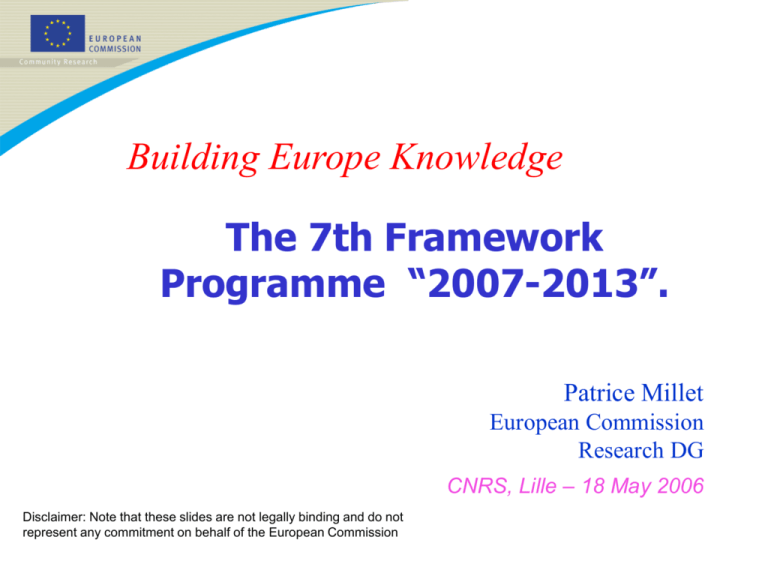
Building Europe Knowledge The 7th Framework Programme “2007-2013”. Patrice Millet European Commission Research DG CNRS, Lille – 18 May 2006 Disclaimer: Note that these slides are not legally binding and do not represent any commitment on behalf of the European Commission The FP and the Specific Programmes The Framework Programme is the strategic instrument for RTD policy (Chapter XVIII of the Treaty): – General principles, objectives, financial means – Co-decision (Council and Parliament) The FP is implemented by Specific Programmes: – Detailed research content – Types of activities and where they apply – More detailed budget Budgets of the EU Framework Programmes 80 € Billion 70 Approx 50 Billion € 60 Council December 2005 68,3 50 40 30 20 10 13,12 3,27 5,36 14,96 17,5 6,6 0 1984-1987 1987-1991 1990-1994 1994-1998 1998-2002 2002-2006 2007-2013 R&D – European weaknesses EU-25 US Japan R&D intensity (% of GDP) (3) 1.97 2.59 3.12 Share of R&D financed by industry (%) (2) 55.9 63.1 73.9 5.5 9.0 9.7 38.3 31.1 9.6 Scientific publications per million population (3) 639 809 569 Share of world triadic patents (%) (1) 31.5 34.3 26.9 Triadic patents per million population (1) 30.5 53.1 92.6 19.7 28.5 26.5 16.7 20.0 10.6 Researchers per thousand labour force (FTE) Share of world scientific publications (%) (3) (3) High-tech exports as a share of total manufacturing exports (%) (3) Share of world high-tech exports (%) (2) Note: (1) 2000 data (2) 2002 data (3) 2003 data Why double the FP7 budget? Tackle under-investment by exerting leverage on national and private investment – Increase EU spending on R&D : 1.97% of GDP vs 2.59% (US) – Help leverage business R&D (EU wide projects, solutions and market) – Brings EU public R&D spending to 0.96% of GDP (close to 1% target) – Encourage Member States Tackle fragmentation of research effort in the EU and enhance its efficiency and effectiveness – Achieve critical mass, share knowledge and facilities – Better dissemination across the EU – More excellence through EU wide competition – Less fragmentation through stronger coordination Why double the FP7 budget? Widen the scope of the FP – Launch essential new initiatives (ERC) – Reinforce existing successful actions Help to meet new S&T challenges – Rising costs of research mean that higher funding is needed to produce same impacts – New research fields are emerging (hydrogen economy etc) Reinvigorate the Lisbon strategy – Objective: to become the most dynamic knowledge-based economy – Supports the integration and attractiveness of the ERA – Contributes to increased competitiveness – Contributes to sustainable development FP7 - What’s new ? Main new elements compared to FP6: Annual budget strongly increased (€ 5 billion ►8.5 billion) Basic research (~ € 1 billion per year) Simplification of procedures Logistical and administrative tasks transferred to external structures (proposition) FP7 2007 - 2013 Specific Programmes Cooperation – Collaborative research Ideas – Frontier Research People – Human Potential Capacities – Research Capacity + JRC (non-nuclear) JRC (nuclear) Euratom FP7 budget (EUR billion, 2004 constant prices) Euratom 4,193 JRC 1,617 Cooperation 39,134 Capacities 6,594 People 6,279 Ideas 10,447 Towards the Seventh Framework Programme 2007-2013 (“co-decision”) Commission opinion on EP amendments Direct approval if agreement with EP New ! Consultations (online etc) Council 2 CREST 4 5 (within 3 months) Commission Proposal Opinion Common position Amendments (approval within 6 weeks) Conciliation: joint text Adoption (absolute majority of members) FP evaluations European Research Advisory Board (approval within 6 weeks) (within 3 months) 1 3 4 European Parliament Council decides by qualified majority except on EP amendments not approved by the Commission 5 FP7 Timetable 6 April 2005 Commission’s proposal September 2005 ? Specific programmes’ proposal December 2005 ? First reading at EP January 2006 ? Common position at Council March 2006 ? Second reading and approval at EP June 2006 ? Adoption November 2006 ? First calls for proposals December 2006 ? Launch Conference Cooperation – Collaborative research 9 Thematic Priorities 1. 2. 3. 4. 5. 6. 7. 8. 9. Health Food, agriculture and biotechnology Information and communication technologies Nanosciences, nanotechnologies, materials and new production technologies Energy Environment (including climate change) Transport (including aeronautics) Socio-economic sciences and the humanities Security and space + Euratom: Fusion energy research, nuclear fission and radiation protection FP7 2007-2013 ‘Cooperation’ budget I. Cooperation Budget (€ million, 2004 constant prices) 1. Health 2. Biotechnology, food and agriculture 3. Information society 4. Nanotechnologies, materials and production 5. Energy 6. Environment 7. Transport 8. Socio-economic research 9. Security and space Total * Not including non-nuclear activities of the Joint Research Centre: €1 617 million 7 325 2 163 11 159 4 256 2 581 2 232 5 232 698 3 488 39 134* Nanosciences, nanotechnologies, materials and new production technologies Overall objective: Improve the competitiveness of EU industry (including SMEs) and ensure its transformation through: – the effective transition from a resource-based to knowledgebased industry – generation of new breakthrough, applicable, knowledge – strengthening EU leadership in nano, materials and production technologies – emphasis on integrating different technologies and disciplines across many sectors 4. Nanosciences, Nanotechnologies, Materials and new Production Technologies Nanosciences and Nanotechnologies Materials New Production Integration of technologies for industrial applications Nanosciences and Nanotechnologies based on the presentation The Strategy and Actions Proposed by the European Commission Renzo Tomellini Head of the Nanosciences and Nanotechnologies Unit European Commission Research DG renzo.tomellini@cec.eu.int Nanotechnology has an extraordinary potential Medicine and Health Drug delivery Information Technology GMR Hard Disk Energy Production / Storage Hydrogen Fuel Cells Materials Science Lightweight and strong Food, Water and the Environment Remediation methods • to serve citizens and satisfy their needs • to support industrial competitiveness Instruments Tunneling microscopy Meeting Millennium Development Goals Applications where nanotechnology can help (e.g.): Water treatment and remediation (de-pollution: visible light photocatalysed systems) Energy production, storage and conversion (solar cells) Disease diagnosis and screening (early prevention) Drug delivery systems (AIDS, malaria, cancer) Health monitoring (and prevention of illnesses: self-cleaning surfaces and devices) Air pollution and remediation Food processing and storage (food safety and quality, sustainable and intelligent packaging) Vector and pest detection and control (targeted pesticides) Agricultural productivity enhancement (local resources) Source: “Innovation: applying knowledge in development”, UN The European Commission is engaged creating a favourable ground for the development of nanosciences and nanotechnologies in Europe and supporting research, so to benefit to the quality of life of citizens and to the European society as a whole, to strengthen the scientific and technological bases of Community industry and to encourage it becoming more competitive at international level, as stated in Art. 163 of the Treaty establishing the European Community (EC) and as it is intended within the spirit of the “Lisbon objectives”. “Nano-related” activities in a vast range of fields: research, education, innovation, regulation, … The European approach: integrated, safe and responsible Two Communications by the European Commission: Towards a European strategy for nanotechnology and the Action Plan COM(2005) 243 COM(2004) 338 of 7.6.2005 of 12.5.2004 Societal Issues Health, safety, environmental and consumer protection Infrastructure Research and Development Industrial Innovation Human Resources http://cordis.europa.eu.int/nanotechnology/actionplan.htm International Co-operation What does an integrated and responsible approach imply? Identifying and addressing all factors for success, research, infrastructure, education, patenting, innovation, safety, communication … Developing safe and cost-effective measures Developing terminology, guidelines, models and standards for risk assessment throughout the whole life-cycle of products of nanotechnology Examining and, where appropriate, proposing adaptations of regulation An Added Value: International Co-operation The E. Commission seeks international debate on nanotechnologyrelated issues such as public health, safety, environment, consumer protection, risk assessment, metrology, norms, …; The EU R&D programmes are open to the World; Europe even funds research teams in Third Countries; Europe promotes the monitoring and sharing at international level of information related to the scientific, technological, economical & social development of nanotechnology; Europe strives for an international “code ofconduct” for the responsible development of nanotechnology and to avoid a “nanodivide”. Nanotechnology R&D expenditures in 2004 Public R&D Investment (€) R&D expenditure ( M€ ) 3,000 Private 1700 2,000 Private 580 1,000 Member States + Associated 980 Private 1540 States 333 Private 370 Federal 910 EC 370 Public 750 Public 540 0 Europe Source: European Commission (2005) US Japan Others EU Public Investment for Nanotechnology in 2004 Public expenditure ( M € ) 400,00 373 293 300,00 224 200,00 124 100 100,00 67 60 60 33 15 15 13 13 9 U ni te Source: European Commission (2005) k G re ec e en m ar ai n Sp ia us tr A en nd Fi nl a Ire la nd ly Ita Sw ed D et he r la nd d s K A in ss gd oc om ia te d St at es B el gi um e nc Fr a N G er EC m an y 0,00 1 Nanotechnology R&D in the EU 6th FP Infrastructure, 16.46 ERA-NET, 3.20 SMEs, 0.91 NEST, 5.06 Science and Society, 1.09 Marie Curie, 50.73 ERA-NET, 2.2 SMEs, 13.77 NEST, 8.15 Marie Curie, 39.73 NMP, 209.01 NMP, 211.61 IST, 99.57 IST, 180.03 2004 ~370 € million FP4(1994-98): 30M€/year FP5(1998-2002): 45M€/year 2005 ~470 € million Areas Supported by the FPs (see the increase of nanomedicine) 100% 90% 80% 70% Health / Environment Research Training Nanotools Nanoelectronics Nanobio / Nanomedicine Nanomaterials Frontier Research 60% 50% 40% 30% 20% 10% 0% FP4 FP5 FP6 European Patents in Nanotechnology Source: European Patent Office, M. Scheu (2004) Nanosciences, nanotechnologies, materials and new production technologies Nanosciences and Nanotechnologies (FP) Objective: – Increase and support the take up of knowledge generated in this revolutionary field for all industrial sectors Topics include: – interface and size dependent phenomena – materials properties at nano-scale – self assembly – metrology – new concepts and approaches – impacts on health and safety – convergence of emerging technologies Specific Programme Nanosciences and nanotechnologies The objective is to create materials and systems with pre-defined properties and behaviour, based on increased knowledge and experience with matter at the nano scale. This will lead to a new generation of high added-value, competitive products and services with superior performance across a range of applications, while minimising any potential adverse environmental and health impacts. Interdisciplinarity, integrating theoretical and experimental approaches, will be promoted. The focus will be new knowledge on the interactions of atoms, molecules and their aggregations with both natural and artificial entities. The research will also address the relevant instruments, tools, pilot lines and demonstration activities required for highly novel approaches to nanotechnology-based manufacturing in the most promising industrial sectors. In addition, the activity will focus on related challenges and the societal context and acceptance of nanotechnology. This will include research on all aspects of risk assessment (e.g. nanotoxicology and -ecotoxicology), as well as safety, nomenclature, metrology and standards which are becoming increasingly important to pave the way for industrial applications. Specific actions will also be launched for establishing dedicated centres of knowledge and expertise as well as a focal point to implement the Commission’s integrated and responsible approach towards nanotechnology as outlined in the associated Action Plan[1]. [1] Commission Communication, Nanosciences and Nanotechnologies: an action plan for Europe 2005-09 - COM(2005) 243. Nanosciences, nanotechnologies, materials and new production technologies Materials (FP) Objective: – generate new knowledge to enable new industrial products and processes to be achieved, exploiting the potential of interdisciplinary approaches in materials research. Topics include: – high performance, sustainable and knowledge-based materials – design and simulation – nano-, bio- and hybrid materials and their processing – chemical technologies – materials processing industries Specific Programme Materials New advanced materials with higher knowledge content, new functionalities and improved performance are increasingly critical for industrial competitiveness and sustainable development. According to the new models of manufacturing industry, it is the materials themselves which are becoming the first step in increasing the value of products and their performance, rather than the processing steps. Research will focus on developing new knowledge-based materials with tailored properties. This requires an intelligent control of intrinsic properties, processing and production, and taking into account potential impacts on health and the environment throughout their entire life-cycle. Emphasis will be placed on new advanced materials obtained using the potential of nanotechnologies and biotechnologies and/or “learning from nature”, in particular higher performance nano-materials, bio-materials and hybrid materials. A multidisciplinary approach will be fostered, involving chemistry, physics and increasingly the biological sciences. Materials characterisation, design and simulation are also essential to better understand materials phenomena, in particular the structure–property relationships at different scales; to improve materials assessment and reliability, and to extend the concept of virtual materials for materials design. The integration of nano-molecular-macro levels in chemical and materials technologies will be supported for developing new concepts and processes such as in catalysis, and process intensification and optimisation. Nanosciences, nanotechnologies, materials and new production technologies New production (FP) Objective: – create continuously innovating production capabilities to achieve leadership in industrial products & processes in the global marketplace. Topics include: – Knowledge-intensive production – new paradigms for emerging industrial needs – adaptive, networked and knowledge-based production – convergence of technologies for next generation of high value-added products (nano, bio, info, cognitive..) Specific Programme New Production Technologies A new approach to manufacturing is required for the transformation of EU industry from a resource intensive to a knowledge-based industrial environment and will depend on the adoption of totally new attitudes towards the continued acquisition, deployment, protection and funding of new knowledge and its use, including towards sustainable production and consumption patterns. This entails creating the right conditions for continuous innovation (in industrial activities and production systems, including construction, devices, and services) and for developing generic production “assets” (technologies, organisation and production facilities) while also meeting safety and environmental requirements. The research will focus on a number of strands: the development and validation of new industrial models and strategies covering all aspects of product and process life-cycle; adaptive production systems that overcome existing process limitations and enable new manufacturing and processing methods; networked production to develop tools and methods for co-operative and value-added operations at a global scale; tools for the rapid transfer and integration of new technologies into the design and operation of manufacturing processes; and the exploitation of the convergence of the nano-, bio-, infoand cognitive technologies to develop new products and engineering concepts and the possibility of new industries. Nanosciences, nanotechnologies, materials and new production technologies Integration of technologies for industrial applications (FP) Objective: – accelerate the rate of industrial transformation by exploiting the application potential and integration of new technologies. Topics include: – Integration of nano, materials and production technologies in sectoral and cross-sectoral applications (e.g. health, construction, transport, energy, chemistry, environment, textiles & clothing, pulp & paper, mechanical engineering) Specific Programme Integration of technologies for industrial applications The integration of knowledge and technologies of the three areas of research above is essential in order to speed up the transformation of European industry and its economy, while adopting a safe, socially responsible and sustainable approach. The research will focus on new applications and novel, step-change solutions responding to major challenges, as well as to the RTD needs identified by the different European Technology Platforms. The integration of new knowledge and nano-, materials-, and production-technologies will be supported in sectoral and cross-sectoral applications such as health, construction, space industry, transport, energy, chemistry, environment, textiles and clothing, pulp and paper, and mechanical engineering, as well as in the generic subject of industrial safety. Importance of Technology Platforms to help establish common research priorities and targets Strategic Research Agendas Extracted from the communication COM(2005) 118 final page 8 “The 7th Framework Programme is tailored to better meet industry’s needs. Where industrially relevant, the definition of work programmes will draw on the strategic research agendas developed by industry-led technology platforms. These strategic research agendas, presenting the European dimension of research challenges, also influence national research programmes. Furthermore, by always looking at the market potential of new inventions, they help to overcome Europe’s weakness in commercialising the results of research.” Cooperation – Collaborative research Under each theme there will be sufficient flexibility to address both Emerging needs and Unforeseen policy needs Dissemination of knowledge and transfer of results will be supported in all thematic areas Support will be implemented across all themes through: Collaborative research (Collaborative projects; Networks of Excellence; Coordination/support actions) Joint Technology Initiatives Coordination of non-Community research programmes (ERA-NET; ERA-NET+; Article 169) International Cooperation Research Infrastructures European Community FP7 Participation Rules (Commission proposal adopted 23.12.05) Minimum conditions for participation General: Three independent participants from three different Member States (MS) or Associated countries (Ac) Natural persons may participate JRC may participate and is deemed to be from a different MS or associated country (same principles for international European interest organisations and entities established under Community law) Additional conditions can be established by the work programme or specific programme (i.e. re number of participants, place of establishment, type of participant) Sole participants composed of members that meet the criteria above can participate Minimum conditions for participation Specific: Frontier research actions (ERC): – at least one legal entity established in a Member State or Associated country Coordination and support actions and actions in favour of training and career development of researchers – minimum of one legal entity (no limit on place of establishment) Collaborative projects addressing the participation of international cooperation partner countries in parity with MS or Ac – minimum is four participants of which 2 in MS or Ac and 2 in INCO countries Participation of international organisations and participants from third countries if in addition to minima Submission and Evaluation Commission to adopt and publish rules on the procedures for proposal submission, evaluation, selection and award – Including two-stage submission and two-step evaluation Commission to adopt and publish rules to ensure consistent verification of the legal status and financial capacity of participants Evaluation criteria established in Specific Programmes and work programmes Irregularity and violation of fundamental ethical principles are grounds for exclusion from evaluation and selection Transparent, fair and impartial evaluation procedures with help of independent experts Maximum funding rates • Research and technological activities – 50% of eligible costs except that for: ▫ Public bodies – 75% ▫ Secondary and higher education establishments – 75% ▫ Research organisations (non-profit) – 75% ▫ SMEs – 75% • Demonstration activities – 50% of eligible costs • Other activities – 100% of eligible costs • Frontier research actions – 100% • Coordination and support actions – 100% • Training and career development of researchers actions – 100% Community financial contribution Eligibility for Funding : – Legal entities from Member States and Associated countries or created under Community law (and JRC) – International European interest organisations – Legal entities established in international cooperation partner (INCO) countries and – International organisations, third countries other than INCO, if provided for in specific programme or work programme; or essential for carrying out action; or provision for funding is provided for in a bilateral agreement between Community and the third country Basis for Funding: – Reimbursement of eligible costs – Flat rates, including scale of unit costs – Lump sum amounts Reimbursement of eligible costs • Co-financing, no profit • May be combined with the pre-set lump sums • and/or flat rates for certain items of a project • Cost reporting models eliminated • Participants charge direct and indirect costs (option of flat rate for those who do not or can not charge real indirect costs) • Costs must be actual; incurred during the project; determined according to the usual accounting and management principles/practices and used only to achieve project objectives, and consistent with principles of economy, efficiency and effectiveness; recorded in accounts and paid (or the accounts of third parties); exclusive of non-eligible costs • Average personnel costs may be used if consistent with above and do not differ significantly from actual • Audit certificates continued but rationalised Lump sum and flat rate financing • Lump sum and/or flat rate financing (scale of unit costs) could be used for the whole action, or • Flat-rates/lump sums for certain costs can be combined with reimbursement of eligible costs • A specific lump sum is identified for Networks of Excellence (NoEs) (unless otherwise provided for in work programme), – calculated according to the number of researchers to be integrated (€ 23,500 / year / researcher) – payment of which is based on attainment of progress • Lump sums and flat rates do not require justification of eligible costs Ideas – the background* Basic research has an important impact on economic performance Europe is not making the most of its research capabilities A new funding mechanism is needed at European level – to reinforce excellence – based on competitive support to individual teams – sole criterion for selection should be scientific excellence European added value through impact of Europe-scale funding The “Ideas” programme in the FP7 proposal Frontier research Support to individual teams, to promote excellence through Europe-wide competition Dedicated implementation structure (Executive Agency) Independent scientific governance (Scientific Council) Simplified grant mechanism Individual teams European added value through Europe-wide competition: Encouraging and supporting the finest talent Selecting the most promising research areas Giving European visibility to research leaders Catalysing the creation of a more efficient European research system ERC Scientific Council Independent; respected personalities, reflecting the full scope of European research Responsible for scientific strategy, oversight and guarantee of quality in scientific decision-making Prior to FP7 decision, would act as advisory body in the development of the “Ideas” programme The ERC Launch Strategy In the start up phase, priority will be given to an ERC Starting Independent Researcher Grant scheme (ERC Starting Grant) (to provide adequate support to the independent careers of excellent researchers who are at the stage of establishing their first research team or program) A second funding stream, the ERC Advanced Investigator Grant scheme (ERC Advanced Grant) will be established (for projects led by Investigators at all subsequent career stages) Technology Platforms Industry-Driven, Competitiveness-Focused European Technology Platforms - Concept Stakeholders, led by industry, get together to define a Strategic Research Agenda on a number of strategically important issues with high societal relevance where achieving Europe’s future growth, competitiveness and sustainable objectives is dependent upon major research and technological advances in the medium to long term. Technology Platforms Bottom-Up Approach with Industry in Lead Wide Stakeholder Involvement Flexibility: No “One Size Fits All” EU Role: Facilitating and Guiding but not Leading or Owning Majority of Strategic Research Agendas, where Appropriate, Taken into Account in Thematic Priorities of FP7 Minority of Strategic Research Agendas Identified through Dialogue with Industry as Potential “Joint Technology Initiatives” Joint Technology Initiatives May Take the Form of Joint Undertakings – Article 171 of the Treaty – “The Community may set up joint undertakings or any other structure necessary for the efficient execution of Community research, technological development and demonstration programmes” Joint Technology Initiatives Identification criteria include: Added value of European-level intervention Degree and clarity of definition of objective Strength of commitment from industry Scale of impact on industrial competitiveness and growth Importance of contribution to broader policy objectives Capacity to attract additional national support and leverage industry funding Inability of existing instruments to achieve objective Joint Technology Initiatives Firmly Anchored in Thematic Areas of the Cooperation Programme In Fields of Major European Public Interest Six Fields Envisaged at this Stage – innovative medicines – nanoelectronics – embedded systems – aeronautics and air traffic management – hydrogen and fuel cells – global monitoring for environment and security Other Fields Possible Subsequently More info: Patrice MILLET European Commission - DG Research Industrial technologies - Materials Mail: CDMA 4/64 B-1049 Brussels - Belgium Visit Address: Rue du Champ de Mars , B-1050 Brussels Belgium Phone Direct line: +32 (2) 298 51 40 Fax: +32 (2) 296 05 50 E-mail: patrice.millet@cec.eu.int New e-mail: patrice.millet@ec.europa.eu Further Information EU research: http://europa.eu.int/comm/resear ch Seventh Framework Programme: http://europa.eu.int/comm/resear ch/future/index_en.cfm Information on research programmes and projects: http://www.cordis.lu RTD info magazine: http://europa.eu.int/comm/resear ch/rtdinfo/ Information requests: research@cec.eu.int
